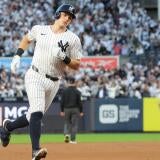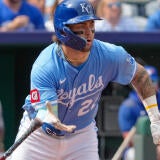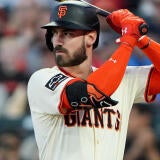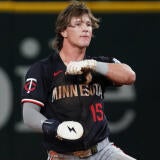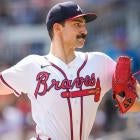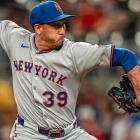Fantasy baseball waiver wire: Spencer Strider's fading fast ball raises concerns for rest of season and beyond
Plus, why Jacob Lopez is worth keeping around for the good matchups

Back in the spring, there was so much optimism around Spencer Strider. Sure, he was coming back from serious elbow surgery, but that didn't seem to matter once we saw him back on the mound. On March 18, he made his spring debut, struck out six of eight batters, and his price in drafts skyrocketed.
Between his debut and the start of the season, Strider's ADP jumped to the No. 72 pitcher in NFBC drafts. Only 16 pitchers ended up being drafted ahead of Strider over those final 10 days of draft season, despite the fact that we knew Strider wasn't going to pitch for at least the first few weeks of the season. People were chasing the "best pitcher in baseball" upside, and it looked like Strider still had it.
There have been flashes, but it's fair to say that Strider has been a pretty major disappointment this season, and hopefully Tuesday's start against the Mets will end up going down as the low point in his season. He was tagged for eight runs in four innings of work, pushing his season-long ERA to 4.69.
And it's pretty clear why it happened. Strider's slider remains an incredibly effective pitch, with a whiff rate over 50% and strong results on balls in play. And the occasional curveball and changeup he's thrown have garnered decent enough results, especially the curveball, which is basically a new pitch for him. The problem, then, is that Strider has gone from having one of the very best fastballs in baseball – maybe the best among starters – to a pretty bad one.
You see it in the results, as his whiff rate is down from 28.7% in 2023 to 16.2% in 2025, while his xwOBA allowed has risen from .317 to .368. And you see it in the stuff, too, as he has lost nearly 2 mph on the pitch and his Stuff+ rating on the pitch has dropped from 118 to 91 (on a scale where 100 is average). And his command of the pitch, which has never been great, has slipped too, with his Location+ dropping from 103 to 97.
And that's a bad thing for any pitcher, but especially for Strider, who has always thrown his fastball at least 54% of the time in every season in the majors. The four-seamer is the only hard pitch he throws, so there isn't an obvious place to pivot if his fastball is gone. He's gone from generating 44% of his strikeouts with the four-seamer in 2023 to just 34% this season, with his whiff rate in two-strike counts dropping from 26.1% to 14.3%.
What does it all mean moving forward? Well, for as mediocre as his overall numbers look now, it's not like the entire season has been a disaster for Strider – he had a 3.71 ERA as recently as two starts ago, and had a 3.53 ERA across June and July. So, at least for the rest of 2025, I think I'm just hanging on to him and hoping this is just a bump in the road and he can still be useful down the stretch.
What we do with Strider for 2026 is a much more interesting question, with much higher stakes. It's not a question we have to answer right now, but it's a question we may not have a satisfying answer for, even with another seven or so weeks of data to rely on. Because Strider remains the most high-profile pitcher to come back from an Internal Brace procedure rather than Tommy John surgery to repair a torn UCL in his pitching elbow.
When it was initially reported that Strider underwent the InternalBrace procedure – wherein the injured ligament is repaired with a suture tape, rather than replaced with a tendon graft, as in a traditional Tommy John surgery – it was viewed as potentially good news. It's a less invasive procedure, and it requires a much shorter recovery time, which is how Strider returned just over a year after injuring the elbow. But it's also a relatively recent procedure at the MLB level – the first players to have the surgery were back in 2016, but according to Jon Roegele's Tommy John Surgery List, there have been fewer than 60 professional baseball players to have the surgery, many of whom were position players.
The most prominent pitcher to have the procedure before Strider was probably Bryan Woo, though he was in college when he had it done. Otherwise, you've got names like Rich Hill, Zach Britton, Sean Doolittle, Vince Velasquez, Lucas Giolito, Patrick Sandoval, and a few others, none of whom were at the top of their game and in their prime like Strider. Which is to say, Strider was very much in unprecedented territory.
And maybe we should have been more cautious when drafting him, as a result. On the whole, pitchers tend to come back from Tommy John surgery more or less as they did before the injury. That isn't guaranteed, and there is usually an adjustment period – see: Alcantara, Sandy (2025) – but generally speaking, betting on a mid-20s pitcher coming back as himself from Tommy John surgery has been a good bet over the years.
We can't necessarily say the same about the Internal Brace surgery. Strider was one of the first real test cases, and so far, he looks like a much-diminished version of himself. But that doesn't mean he will remain so in 2026. Talent isn't static, and Strider could benefit from a relatively normal offseason to get back on track. We do still have to account for the possibility that he'll rediscover at least some of his former skills when ranking and drafting him for 2026.
But he probably can't be a top-100 pick, and he probably shouldn't be a top-30 starting pitcher, either. I haven't even begun to think about who might be ahead of him, so don't hold me to that. But that's where I'm leaning on Strider right now.
Here's what else you need to know about from Tuesday's action around MLB:
Wednesday's top waiver-wire targets
Jacob Lopez, SP, Athletics (61%) – Okay, Jacob Lopez. That's now four straight scoreless starts for Lopez, with 28 strikeouts to six walks in that span, and he's been downright dominant for the last two, striking out 19 with zero walks while going at least seven innings in both. It's the best stretch of his career, and he suddenly has his ERA for the season down to 3.30. And it has coincided with a change to his slider, as he has been throwing it slower, with a couple inches more of both horizontal and vertical break. Is that enough to change Lopez's fortunes entirely? I'm pretty skeptical of that – we did see a similar stretch earlier in the season before his homer issues derailed him, and Lopez still looks like one of the most extreme flyball pitchers in baseball. But man, when he's locked in, he can be really good, with a funky delivery and pitch movement profile that doesn't really look like anyone else in baseball. I think there will be more rough stretches ahead, but seeing him bounce back like this has me open to the idea that Lopez is at least worth keeping around for the good matchups.
Francisco Alvarez, C, Mets (30%) – Alvarez was one of the most hyped catching prospects of the past few years, and now he's hitting .304 with an OPS north of 1.000 since being recalled from a trip down to Triple-A – a trip where he crushed the ball. Now, a lot of that success came from Tuesday's two-homer game, but still, he's been showing a lot more since coming back than he had before his demotion, and he's still just 23, so I'm inclined to give him some benefit of the doubt. The problem is, the catcher position is so deep that there just may not be many one-catcher leagues where he's worth rostering. That's a fair criticism, but there are also 23 catchers rostered in more leagues than Alvarez in CBS Fantasy, and I'd certainly rather take the chance on his upside than the likes of Tyler Stephenson, Ryan Jeffers, or Carson Kelly. So there's still plenty of room for Alvarez's roster rate to grow.
Bryan Abreu, RP, Astros (30%) – We got confirmation of what we feared Tuesday: The Astros placed Josh Hader on the IL with a left shoulder strain. We don't know the extent of the injury, but Abreu looks set to be the team's closer for at least the next couple of weeks, and he should be well-suited to the role, thanks to his near-2.00 ERA over the past four seasons combined. I could see a world where the Astros lean on Bennett Sousa a bit, given their plethora of high-leverage left-handed arms, but Abreu is the best non-Hader pitcher in the bullpen and should be the primary option with him out.
Dylan Crews, OF, Nationals (69%) – Crews was terrible before his oblique injury, but there were more reasons for optimism than you might think. His .274 wOBA was one of the worst marks in baseball, sure, but his .343 xwOBA was actually pretty solid – it's right in line with useful Fantasy options like Pete Crow-Armstrong, Kerry Carpenter, and Taylor Ward, among others. For a guy with 23 career steals in just 76 games, "pretty solid" would be more than good enough. I know Crews has been a big disappointment so far in his career, but with his return from the IL looming, I'm willing to take a chance that there's still a lot of upside left here for the 23-year-old to tap into.
Brandon Sproat/Nolan McLean, SP, Mets – The Mets' decision to shop in the bargain bin for pitching didn't work out with Frankie Montas this season, and he's going to be moved to the bullpen moving forward. Which means the Mets are likely to call on a pitching prospect to join the rotation, with Sproat and McLean both mentioned as possible options. Sproat is probably the one you know of if you've heard of either pitcher, but his prospect standing has also taken a big hit this season, as he has a 4.10 ERA at Triple-A with just a 20.2% strikeout rate. But he's been much better lately, so maybe he's figured something out, with a 1.15 ERA and 43 strikeouts over 39 innings in his past seven starts. McLean has been one of the fast risers in the Mets system, meanwhile, posting a 2.45 ERA and 27.2% strikeout rate across two levels, including a successful run at Triple-A. Both would be interesting adds if they get the call, so keep an eye on this one.
Kyle Manzardo, 1B, Guardians (43%) – Manzardo has kind of fallen off Fantasy radars thanks to a persistently troublesome batting average, but that's actually been a lot better for him lately, as he is hitting .358 with eight homers and 20 RBI over his past 21 games. He's still hitting .244 on the season, but that's actually palatable from a guy who might hit 30 homers. He won't play against every lefty, which limits his value, but Manzardo feels like a nice hot-hand play right now.

